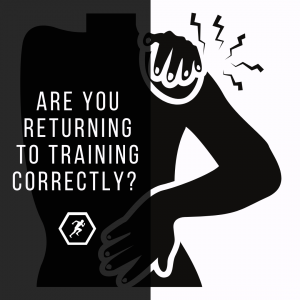 With the COVID-19 pandemic situation now improving and life slowly returning to normality (or the new normal), we now need to plan for an appropriate return to training/performance strategy for all those returning to sport or physical activity.
With the COVID-19 pandemic situation now improving and life slowly returning to normality (or the new normal), we now need to plan for an appropriate return to training/performance strategy for all those returning to sport or physical activity.
The main concern for anyone who has experienced a reduction in training or competitive sport during the lockdown period, is a large, rapid increase in physical workload when returning.
There have been many instances in sport where even in a professional setting, injuries have been caused by not understanding and preparing athletes properly.
A commonly used example is the 2011 NFL lockout, where NFL players were unable to access and use team facilities, resulting in a reduction in overall training and most likely quality of training. Following the lockout when training and gameplay resumed, there was a large increase in injuries, specifically an increase in Achilles ruptures, with numbers increasing from 6-10 ruptures per season to 10 in the preseason period alone (1).
This has also been seen more recently following the return to play in Bundesliga football, with some great data shown by Trackademic (2). With an increase in injuries and a decrease in certain performance measures, it is clear that the importance of returning to training in the correct manner is vital, with some teams and athletes controlling this better than others.
What can we take away from this?
When returning to the gym or training for you sport, you need to be realistic with where you are currently and taper your training upwards gradually to avoid any spikes in training load. A fast increase in training load can be a very large risk factor for injury.
A lot of athletes and regular gym goers will most likely see this as a bad thing, as they are doing less than what was getting them results before, however, it may be beneficial for future training.
If you were one of the many doing home workouts in order to maintain progress, or even stopped training at all… you will have detrained and will now have a lower minimum effective volume (MEV).
What this means is that you will now respond very well to doing less! Instead of doing 15+ sets per week to make progress in your leg sessions for example, you will make good progress with potentially 3-6 sets (depending on training intensity).
Combine this with coming out of lockdown well rested and injury free from less training (hopefully) and you are now in a great position to push past your long term goals! If you managed to maintain or even progress slightly without use of your usual facilities, you will now be progressing from an even better position!
My main recommendations moving forward:
- Start with as little as possible. Even if that means 1 working set on your weight training, plyometrics, sprints or exercise class for example. If you are coming from doing nothing or simple home workouts, that will be enough to progress!
- Limit the intensity. Try not to train to all out failure in the first few weeks. Leave a few reps in the tank and gradually taper the intensity up.
- Monitor muscle soreness closely. If you are not recovering from sessions, you are most likely doing too much and limiting your overall progress. Muscle soreness will most likely be a limiting factor to how much you can do when returning to training.
- Stick with what you know. Now is not a good time to experiment with a new training stimulus. Stick with what has given you good training adaptions previously and work you way towards that.
This week, to celebrate the reopening of gyms I am taking on 5 new online coaching clients (capped following this 5!).
If you need help taking advantage of this period returning to training and want to make sure you do it properly avoiding injury, then please fill out my application form below to see if we are the right fit to work together.
https://highperformancestrategies.wufoo.com/forms/z14qxxod0zqdmlo/
References
(1) Myer, G. D., Faigenbaum, A. D., Cherny, C. E., Heidt Jr, R. S., & Hewett, T. E. (2011). Did the NFL lockout expose the Achilles heel of competitive sports?.
(2) www.trackademicblog.com/blog/thesnapshotbecomesastory
Recent Comments